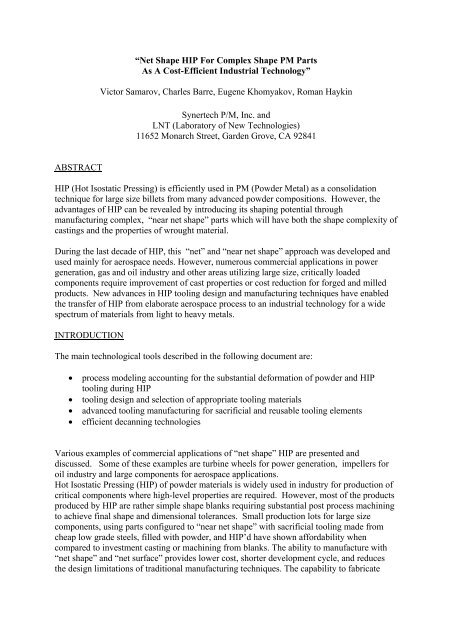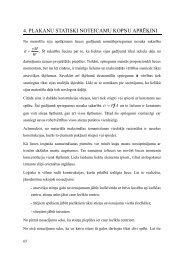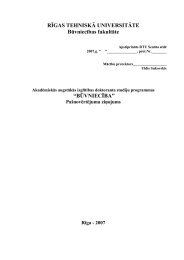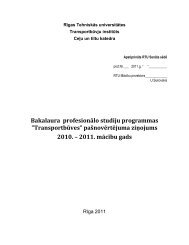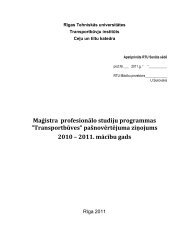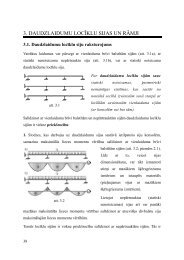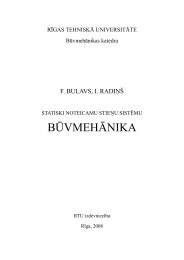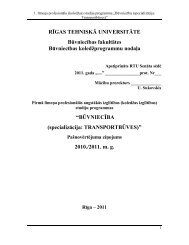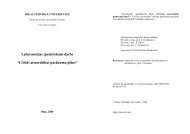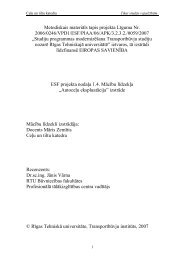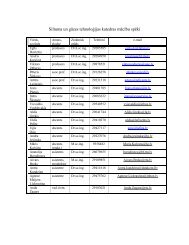âNet Shape HIP for complex shape PM parts as a cost-efficient ...
âNet Shape HIP for complex shape PM parts as a cost-efficient ...
âNet Shape HIP for complex shape PM parts as a cost-efficient ...
You also want an ePaper? Increase the reach of your titles
YUMPU automatically turns print PDFs into web optimized ePapers that Google loves.
“Net <strong>Shape</strong> <strong>HIP</strong> For Complex <strong>Shape</strong> <strong>PM</strong> Parts<br />
As A Cost-Efficient Industrial Technology”<br />
Victor Samarov, Charles Barre, Eugene Khomyakov, Roman Haykin<br />
Synertech P/M, Inc. and<br />
LNT (Laboratory of New Technologies)<br />
11652 Monarch Street, Garden Grove, CA 92841<br />
ABSTRACT<br />
<strong>HIP</strong> (Hot Isostatic Pressing) is <strong>efficient</strong>ly used in <strong>PM</strong> (Powder Metal) <strong>as</strong> a consolidation<br />
technique <strong>for</strong> large size billets from many advanced powder compositions. However, the<br />
advantages of <strong>HIP</strong> can be revealed by introducing its shaping potential through<br />
manufacturing <strong>complex</strong>, “near net <strong>shape</strong>” <strong>parts</strong> which will have both the <strong>shape</strong> <strong>complex</strong>ity of<br />
c<strong>as</strong>tings and the properties of wrought material.<br />
During the l<strong>as</strong>t decade of <strong>HIP</strong>, this “net” and “near net <strong>shape</strong>” approach w<strong>as</strong> developed and<br />
used mainly <strong>for</strong> aerospace needs. However, numerous commercial applications in power<br />
generation, g<strong>as</strong> and oil industry and other are<strong>as</strong> utilizing large size, critically loaded<br />
components require improvement of c<strong>as</strong>t properties or <strong>cost</strong> reduction <strong>for</strong> <strong>for</strong>ged and milled<br />
products. New advances in <strong>HIP</strong> tooling design and manufacturing techniques have enabled<br />
the transfer of <strong>HIP</strong> from elaborate aerospace process to an industrial technology <strong>for</strong> a wide<br />
spectrum of materials from light to heavy metals.<br />
INTRODUCTION<br />
The main technological tools described in the following document are:<br />
• process modeling accounting <strong>for</strong> the substantial de<strong>for</strong>mation of powder and <strong>HIP</strong><br />
tooling during <strong>HIP</strong><br />
• tooling design and selection of appropriate tooling materials<br />
• advanced tooling manufacturing <strong>for</strong> sacrificial and reusable tooling elements<br />
• <strong>efficient</strong> decanning technologies<br />
Various examples of commercial applications of “net <strong>shape</strong>” <strong>HIP</strong> are presented and<br />
discussed. Some of these examples are turbine wheels <strong>for</strong> power generation, impellers <strong>for</strong><br />
oil industry and large components <strong>for</strong> aerospace applications.<br />
Hot Isostatic Pressing (<strong>HIP</strong>) of powder materials is widely used in industry <strong>for</strong> production of<br />
critical components where high-level properties are required. However, most of the products<br />
produced by <strong>HIP</strong> are rather simple <strong>shape</strong> blanks requiring substantial post process machining<br />
to achieve final <strong>shape</strong> and dimensional tolerances. Small production lots <strong>for</strong> large size<br />
components, using <strong>parts</strong> configured to “near net <strong>shape</strong>” with sacrificial tooling made from<br />
cheap low grade steels, filled with powder, and <strong>HIP</strong>’d have shown af<strong>for</strong>dability when<br />
compared to investment c<strong>as</strong>ting or machining from blanks. The ability to manufacture with<br />
“net <strong>shape</strong>” and “net surface” provides lower <strong>cost</strong>, shorter development cycle, and reduces<br />
the design limitations of traditional manufacturing techniques. The capability to fabricate
<strong>complex</strong>, monolithic <strong>shape</strong>s without welding provides enhanced service life <strong>for</strong> critical<br />
components in addition to the fabrication and inspection <strong>cost</strong> savings.<br />
The advancement towards “net <strong>shape</strong>” <strong>HIP</strong> is enabled by process modeling research and<br />
development. The steps to highly desirable “net <strong>shape</strong>” products are improvements to process<br />
models used to design <strong>HIP</strong> tooling. The more advanced modeling accounts <strong>for</strong> pl<strong>as</strong>tic and<br />
creep de<strong>for</strong>mation of compressible powder media interacting with solid <strong>HIP</strong> tooling <strong>as</strong> well<br />
<strong>as</strong> the evolution of material properties during <strong>HIP</strong> cycles. . The final benefit is to reduce the<br />
need <strong>for</strong> time-consuming and <strong>cost</strong>ly experimental iterations by employment of more accurate<br />
first-time-through process modeling.<br />
Currently, critical applications within the industry have continually brought examples of the<br />
technological compromise between per<strong>for</strong>mance characteristics and <strong>cost</strong> that is very often<br />
closely related to dimensional precision. This compromise is the re<strong>as</strong>on <strong>for</strong> the pursuit of an<br />
alternative to the two b<strong>as</strong>ic technological processes of manufacturing <strong>complex</strong> <strong>shape</strong> <strong>parts</strong>:<br />
investment c<strong>as</strong>ting and <strong>for</strong>ging + machining.<br />
The Hot Isostatic Process makes it possible to combine dimensional precision typical<br />
<strong>for</strong> c<strong>as</strong>t <strong>parts</strong> with the properties of a <strong>for</strong>ged material while gaining improved homogeneity of<br />
the microstructure. This can be a potential winner in this competition if the problem of <strong>shape</strong><br />
control during <strong>HIP</strong> is solved. This is one of the most complicated technological issues<br />
because the final “<strong>as</strong> <strong>HIP</strong>” geometry of any part is a result of non-uni<strong>for</strong>m shrinkage of more<br />
or less isotropic powder bulk placed in a <strong>complex</strong> <strong>shape</strong> metal capsule.<br />
<strong>HIP</strong> provides a uni<strong>for</strong>m microstructure and properties, regardless of size and <strong>shape</strong>, which<br />
can be extremely <strong>efficient</strong> and important <strong>for</strong> the development of large size, <strong>complex</strong> <strong>shape</strong><br />
<strong>parts</strong>. For example, the new generation of highly powered jet and rocket engines h<strong>as</strong><br />
critically loaded components that can reach up to 454 kg (1000 lbs) in weight and 1270 mm<br />
(50”) in diameter. Very often, <strong>PM</strong>/<strong>HIP</strong> is the only technology providing the necessary<br />
combination of <strong>cost</strong> and per<strong>for</strong>mance. The potential applications are both static and rotating<br />
components.<br />
Some examples include: impellers, turbine and pump wheels, housings, manifolds and<br />
jackets, all made from existing advanced high strength and environmentally compatible<br />
powder alloys. The only way to economically manufacture these components from advanced<br />
powder alloys is to produce them with selectively net <strong>shape</strong>, avoiding welds and machining<br />
of intricate internal surfaces.<br />
Selectively Net <strong>Shape</strong> Hot Isostatic Pressing (SNS <strong>HIP</strong>) is b<strong>as</strong>ed on the computer modeling<br />
of tooling using existing Computer Aided Designs (CAD) that would, when combined with<br />
powder, result in a “net <strong>shape</strong>” part per drawing requirements. This process can be directly<br />
applicable to static and rotating <strong>parts</strong> and the large structures made from high strength and<br />
environmentally compatible Nickel and Iron b<strong>as</strong>ed Superalloys, <strong>as</strong> well <strong>as</strong>, Titanium alloys.<br />
There are four b<strong>as</strong>ic technological tools within <strong>HIP</strong> technology that enable us to solve the<br />
problem of “net <strong>shape</strong>” manufacturing. These tools also supply a developmental ef<strong>for</strong>t, which<br />
is a reliable and reproducible manufacturing of a <strong>complex</strong> <strong>shape</strong> part by <strong>HIP</strong>. They are:<br />
1) Adequate process modeling that enables us to describe and optimize the flow pattern.
2) Optimal <strong>HIP</strong> tooling design, which helps to eliminate distortions and to minimize the<br />
influence of stoch<strong>as</strong>tic factors.<br />
3) Experimental step through an in<strong>for</strong>mative demonstrator revealing the details of the<br />
de<strong>for</strong>mation, map which could not be predicted within the model of the process while<br />
supplying necessary additional in<strong>for</strong>mation and<br />
4) Iterative in<strong>for</strong>mation loop b<strong>as</strong>ed on the computer analysis of dimensional data files,<br />
starting with the specification of the part through modeling and capsule design to “<strong>as</strong><br />
<strong>HIP</strong>” geometry.<br />
Consistent use of these tools provides the possibility of decre<strong>as</strong>ing the development period<br />
by 4-6 months. These tools also offer <strong>efficient</strong> manufacturing of <strong>complex</strong> <strong>shape</strong>d engine<br />
<strong>parts</strong>.<br />
New solutions to these problems can be revealed in the field of advanced mathematical<br />
modeling of <strong>HIP</strong> shrinkage accounting. This is evident through the actual 2D and 3D<br />
geometry, showing boundary conditions at the powder-tooling interface, inherent anisotropy<br />
of pores evolution and very special theology of the processed media consisting partially of<br />
compressible (powder) and non-compressible (inserts) materials. These solutions far surp<strong>as</strong>s<br />
the traditional concept of a <strong>HIP</strong> capsule <strong>as</strong> just a can transferring isostatic pressure to the<br />
powder and providing its 100% density. The capsule <strong>for</strong> a <strong>complex</strong> <strong>shape</strong> part appears <strong>as</strong> a<br />
pl<strong>as</strong>tically de<strong>for</strong>med special technological shaping tool.<br />
It is also important to keep in mind that the stoch<strong>as</strong>tic characters of most technological<br />
parameters involved are of non-negligible influence on the<br />
shrinkage. Due to this influence, it is practically impossible to ensure “net <strong>shape</strong>” geometry<br />
of the entire part, inclusive of its internal surfaces. Today’s level of computer modeling and<br />
CAD open the possibilities <strong>for</strong> <strong>efficient</strong> control of the shrinkage and stable manufacturing of<br />
<strong>parts</strong> with critical “net” surfaces.<br />
Shrinkage of powder material during <strong>HIP</strong> occurs due to the following mechanisms of<br />
de<strong>for</strong>mation: pl<strong>as</strong>ticity, creep and diffusion. Strict accounting of these mechanisms is an<br />
extremely complicated t<strong>as</strong>k, and one should determine rheological characteristics of material.<br />
It h<strong>as</strong> been proven that an adequate description of shrinkage <strong>for</strong> typical <strong>HIP</strong> cycles may be<br />
done on the b<strong>as</strong>is of pl<strong>as</strong>ticity theory applied to powder materials [1,2,3].<br />
The main distortion of powder placed in steel capsules takes place on the first stage of<br />
densification, during the pl<strong>as</strong>tic de<strong>for</strong>mation of powder. Further densification goes on under<br />
constantly growing pressure. Meanwhile, the powder is at a limited (yield stress-strained)<br />
state.
Only in the final (dwell) stage of densification, when the main densification is over, do the<br />
mechanisms of high temperature de<strong>for</strong>mation start working. The t<strong>as</strong>k of simulation of the<br />
shrinkage regularities can be reduced to the solution of a system of pl<strong>as</strong>ticity theory<br />
equations. These theories include: equilibrium equations, cinematic equations <strong>for</strong><br />
de<strong>for</strong>mation rate components, discontinuity equation, determination equations, thermal<br />
conductivity equations and Green’s pl<strong>as</strong>ticity criterion.<br />
For example (Green’s pl<strong>as</strong>ticity criterion):<br />
Τ<br />
f<br />
2<br />
2<br />
1<br />
2<br />
σ<br />
f<br />
+ =<br />
0<br />
2<br />
2<br />
2<br />
τ s<br />
, where f 1 and f 2 - some functions accounting the effect of average stress σ 0 and<br />
stress intensity factor T on densification and function of yield strength τ s versus density.<br />
In the c<strong>as</strong>e of pl<strong>as</strong>tic flow of incompressible capsule material the continuity hypothesis turns<br />
into an incompressibility equation.<br />
Solutions of the closed equation set enable us to describe shrinkage of a powder work piece<br />
in a metal capsule, defining cinematic characteristics, stress-strain state parameters and<br />
distribution of density in the powder volume. An adherence law is <strong>as</strong>sumed on the contact<br />
surface between powder and capsule.<br />
The Finite Element technique is the computational method used in the software developed<br />
[2]. The area of application and validity is 2D axysimmetric and 3D <strong>parts</strong> with <strong>complex</strong><br />
geometry.<br />
The main problem, which determines the adequacy and effectiveness of the model of <strong>HIP</strong>, is<br />
data b<strong>as</strong>e creation <strong>for</strong> powder materials. For creating such data b<strong>as</strong>e, f 1 and f 2 functions<br />
from the main equations and pl<strong>as</strong>ticity criterion are necessary.<br />
These functions determine the average stress and density relationship and sheer stress<br />
influence on the densification. It is obvious however, that the temperature factor is important<br />
and should be included directly or indirectly into the equations.<br />
Experiments to identify f 1 and f 2 include interrupted <strong>HIP</strong> cycles and pl<strong>as</strong>tic de<strong>for</strong>mation<br />
(upsetting at elevated temperatures) tests [4]. <strong>HIP</strong> tests are imitating regimes of a real<br />
technological process. The nest important item of the procedure is the definition of conditions<br />
of pl<strong>as</strong>tic de<strong>for</strong>mation tests of the densified material. As the material is always in the limited<br />
stress-strained state during <strong>HIP</strong>, temperature conditions of the shear tests should be the same<br />
<strong>as</strong> they were during <strong>HIP</strong>ing. Hot upsetting at corresponding temperatures is used <strong>for</strong> the<br />
pl<strong>as</strong>tic de<strong>for</strong>mation tests.<br />
As a result, the development process b<strong>as</strong>ed on advanced modeling consists of the following<br />
steps:<br />
• Generation of the file describing the geometry of an “<strong>as</strong>-<strong>HIP</strong>” piece;<br />
• 2D modeling and development of the optimal capsule design;<br />
• 3D modeling of densification and shrinkage during <strong>HIP</strong> and generation of the CAD<br />
file with the geometry of capsule and inserts <strong>for</strong>ming the blades;<br />
• Development of the software <strong>for</strong> NC milling or EDM;
• Manufacturing of the pilot set of tooling and <strong>HIP</strong> of the demonstrator;<br />
• 3D me<strong>as</strong>urements, computer processing, modeling and correction of the CAD file;<br />
• Manufacturing of tooling and production of prototype part in accordance with<br />
specifications.<br />
The manufacturing of large, <strong>complex</strong> geometry <strong>parts</strong> from “Hot Isostatically Pressed” (<strong>HIP</strong>)<br />
powder of Nickel and Iron b<strong>as</strong>ed super alloys and Ti alloys requires tooling designed from<br />
computer programs with embedded engineering models of powder consolidation and<br />
shrinkage that use the Computer Aided Design (CAD) model of the desired part. The Powder<br />
Metal – <strong>HIP</strong> process b<strong>as</strong>ed on modeling h<strong>as</strong> brought the opportunity to have investment c<strong>as</strong>t<br />
dimensional precision with material properties closer to <strong>for</strong>ging and machined properties.<br />
The desire to use this (<strong>parts</strong> from powder) approach is largely due to the ability to reproduce<br />
investment c<strong>as</strong>t configurations, often with better dimensional control, that have improved<br />
material properties which result from homogeneous microstructure.<br />
Forming during <strong>HIP</strong> is accomplished using tooling capsules, designed from the CAD model<br />
part, which provide the initial <strong>shape</strong> <strong>for</strong> the powder material and control the de<strong>for</strong>mation<br />
pattern during its densification. Though this tooling is sacrificial, <strong>for</strong> small production lots<br />
(10 or less), which is typical <strong>for</strong> rocket engine components, the Powder Metal in a tool-<strong>HIP</strong><br />
process h<strong>as</strong> been shown to be <strong>cost</strong> effective when compared to investment c<strong>as</strong>tings or<br />
machining from raw material blanks. The <strong>cost</strong> of tooling capsules made from cheap low<br />
grade steels is much less than that of the high per<strong>for</strong>mance material to be machined off a<br />
blank to provide a net <strong>shape</strong> part. Additionally, the investment c<strong>as</strong>ting tooling <strong>cost</strong>s are not<br />
<strong>efficient</strong> at low production quantities.<br />
Figures 1 and 2 show the development and processing steps in Synertech P.M’s current<br />
technology <strong>as</strong> recently applied in a demonstration program with Boeing-Rocketdyne on a<br />
selectively-net-<strong>shape</strong> <strong>HIP</strong> powder metal turbine housing (IPD fuel turbopump).<br />
Manufacturing Flow Chart at Synertech P/M<br />
Fuel Turbine Tooling Assembly Tooling Capsule Powder filled,<br />
Housing Design Low Carbon Iron Deg<strong>as</strong>sed and <strong>HIP</strong>’d<br />
Partial Tool Removal Complete Tooling Removal Finish Machining of<br />
By PreMachining by Selective Acid Leaching Superalloy Housing<br />
Figure 1. Single – Piece Turbine Housing –<br />
No Welds. No C<strong>as</strong>tings. Low Cost Machining
4 Months from a new design concept<br />
Via process modeling,<br />
tooling design,<br />
manufacturing, and <strong>HIP</strong><br />
to a full-scale prototype<br />
Figure 2. SNS <strong>HIP</strong> <strong>as</strong> Efficient Development Tool <strong>for</strong> Large Critical Components<br />
Figures 3 and 4 illustrate different commercial applications in aircraft engines, power<br />
generation, g<strong>as</strong> and oil industry.<br />
Figure 3. Impellers Present the Most Beneficial Applications <strong>for</strong> SNS <strong>HIP</strong>
Conceptual tooling design and FEM modeling<br />
Figure 4. Development of Complex Net <strong>Shape</strong> Parts from Ni-b<strong>as</strong>e Superalloys<br />
Conclusions<br />
• SNS <strong>HIP</strong> Process provides material af<strong>for</strong>dability even <strong>for</strong> expensive powders;<br />
• The Process h<strong>as</strong> been proven <strong>for</strong> Ni, Ti, Be- alloys, high strength steels, and Re<br />
alloys;<br />
• The larger the size of the critical components,- the more benefits <strong>for</strong> SNS <strong>PM</strong> <strong>HIP</strong>;<br />
• SNS <strong>HIP</strong> provides a capability <strong>for</strong> <strong>efficient</strong> re-design of critical components;<br />
• The process is highly competitive <strong>for</strong> small and medium volumes.<br />
References<br />
[1] Samarov, V., Seliverstov, D., “<strong>HIP</strong> Modeling of Complex <strong>Shape</strong> Parts: Experience,<br />
Trends and Perspectives.” Powder Metallurgy World Congress. Proceedings., 1994<br />
[2] Khazami, Zadeh M., “Finite Element Simulation des Heisisostatpressens endkonturnaher<br />
Bauteile”, PhD Thesis, IFAM, Bremen, 1995.<br />
[3] Raisson, G., Samarov, V., “Design Rules <strong>for</strong> Net <strong>Shape</strong> or Near Net <strong>Shape</strong> Components<br />
Produced by Hot Isostatic Pressing of Superalloy Powders”, Powder Metallurgy World<br />
Congress. Proceedings., 1994.<br />
[4] Kratt, E., Samarov, V., Seliverstov, D. , “Development and Manufacturing of “Net<br />
<strong>Shape</strong>” Critical Rotating Parts from a Ni-b<strong>as</strong>e Superalloy”, Proceedings of <strong>HIP</strong>-99<br />
International Conference, Beijing, 1999.


